System Analysis and Design: Himalayan Hotel System - Detailed Report
VerifiedAdded on 2023/06/10
|30
|6842
|133
Report
AI Summary
This report presents a comprehensive system analysis and design case study focusing on the Himalayan Hotel. It begins by exploring different Systems Development Life Cycle (SDLC) models, including the Waterfall, V-Shaped, and Prototyping models, detailing their advantages and disadvantages. The report then delves into a feasibility study, outlining the components of a feasibility report and the importance of feasibility analysis. A systems investigation is conducted, covering system requirement investigation, analysis methodologies, constraints, and operational requirements. Data modeling techniques are applied, and functional and non-functional requirements are addressed. The report concludes by discussing how to address the identified system requirements, providing a thorough analysis and design framework for the Himalayan Hotel system. Desklib offers more solved assignments and past papers for students.
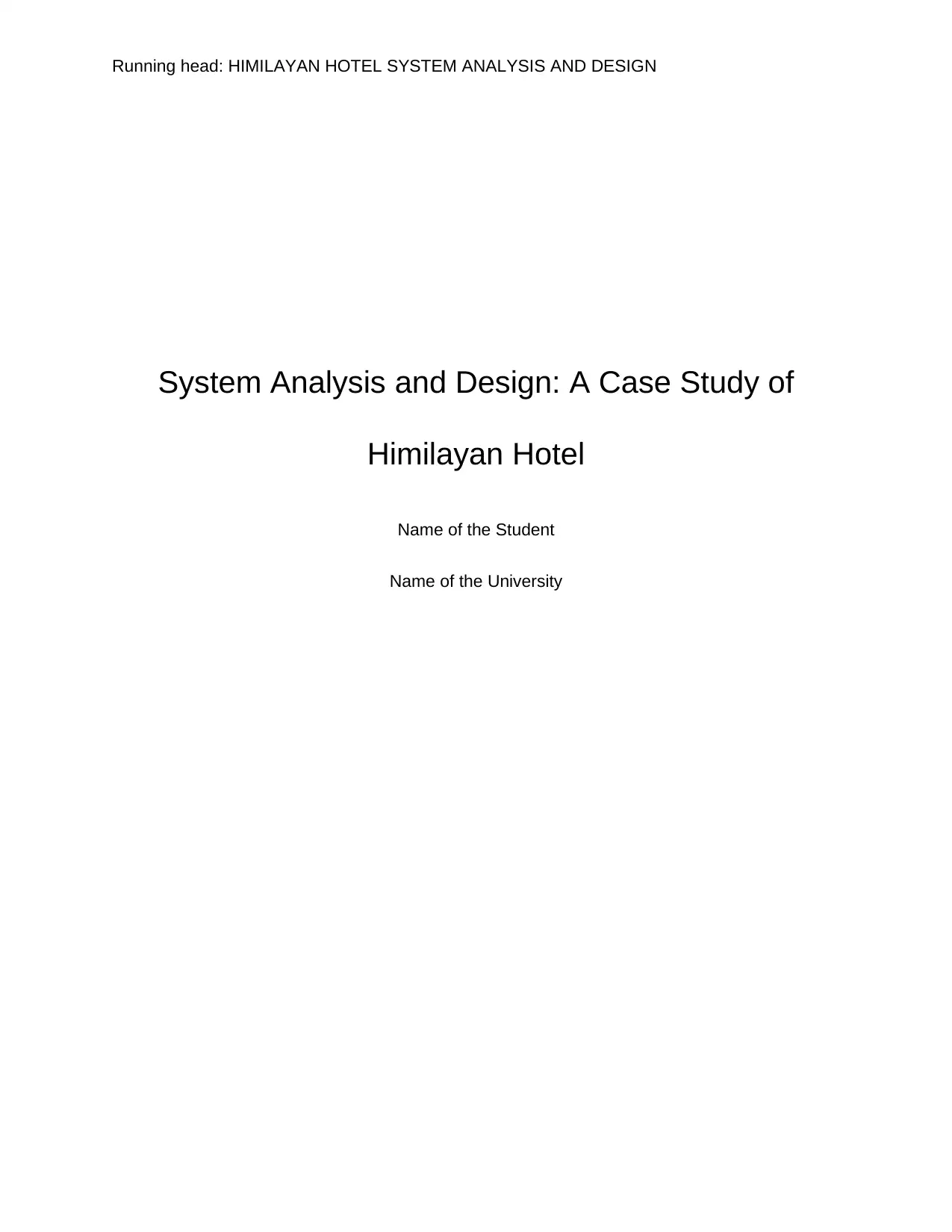
Running head: HIMILAYAN HOTEL SYSTEM ANALYSIS AND DESIGN
System Analysis and Design: A Case Study of
Himilayan Hotel
Name of the Student
Name of the University
System Analysis and Design: A Case Study of
Himilayan Hotel
Name of the Student
Name of the University
Paraphrase This Document
Need a fresh take? Get an instant paraphrase of this document with our AI Paraphraser
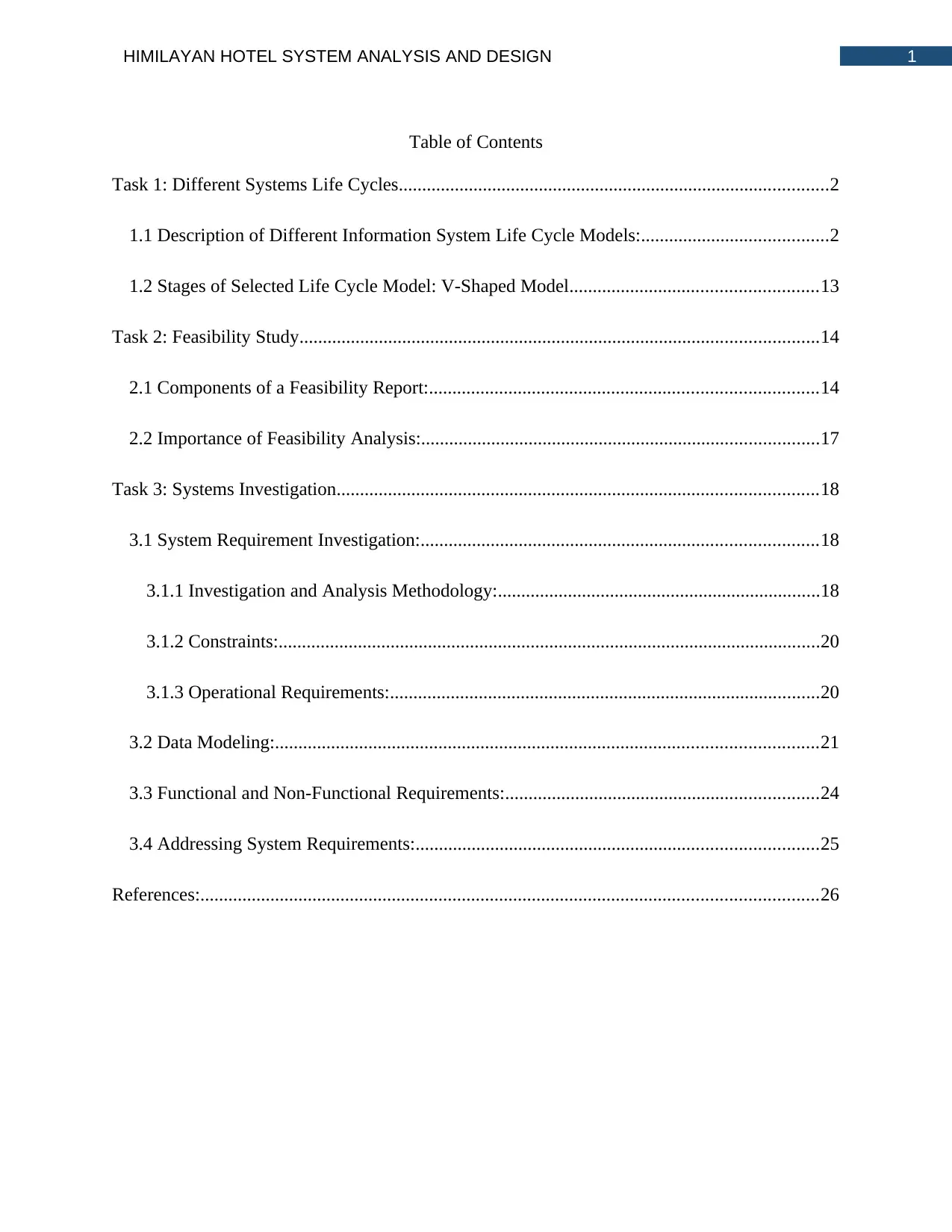
1HIMILAYAN HOTEL SYSTEM ANALYSIS AND DESIGN
Table of Contents
Task 1: Different Systems Life Cycles............................................................................................2
1.1 Description of Different Information System Life Cycle Models:........................................2
1.2 Stages of Selected Life Cycle Model: V-Shaped Model.....................................................13
Task 2: Feasibility Study...............................................................................................................14
2.1 Components of a Feasibility Report:...................................................................................14
2.2 Importance of Feasibility Analysis:.....................................................................................17
Task 3: Systems Investigation.......................................................................................................18
3.1 System Requirement Investigation:.....................................................................................18
3.1.1 Investigation and Analysis Methodology:.....................................................................18
3.1.2 Constraints:....................................................................................................................20
3.1.3 Operational Requirements:............................................................................................20
3.2 Data Modeling:....................................................................................................................21
3.3 Functional and Non-Functional Requirements:...................................................................24
3.4 Addressing System Requirements:......................................................................................25
References:....................................................................................................................................26
Table of Contents
Task 1: Different Systems Life Cycles............................................................................................2
1.1 Description of Different Information System Life Cycle Models:........................................2
1.2 Stages of Selected Life Cycle Model: V-Shaped Model.....................................................13
Task 2: Feasibility Study...............................................................................................................14
2.1 Components of a Feasibility Report:...................................................................................14
2.2 Importance of Feasibility Analysis:.....................................................................................17
Task 3: Systems Investigation.......................................................................................................18
3.1 System Requirement Investigation:.....................................................................................18
3.1.1 Investigation and Analysis Methodology:.....................................................................18
3.1.2 Constraints:....................................................................................................................20
3.1.3 Operational Requirements:............................................................................................20
3.2 Data Modeling:....................................................................................................................21
3.3 Functional and Non-Functional Requirements:...................................................................24
3.4 Addressing System Requirements:......................................................................................25
References:....................................................................................................................................26
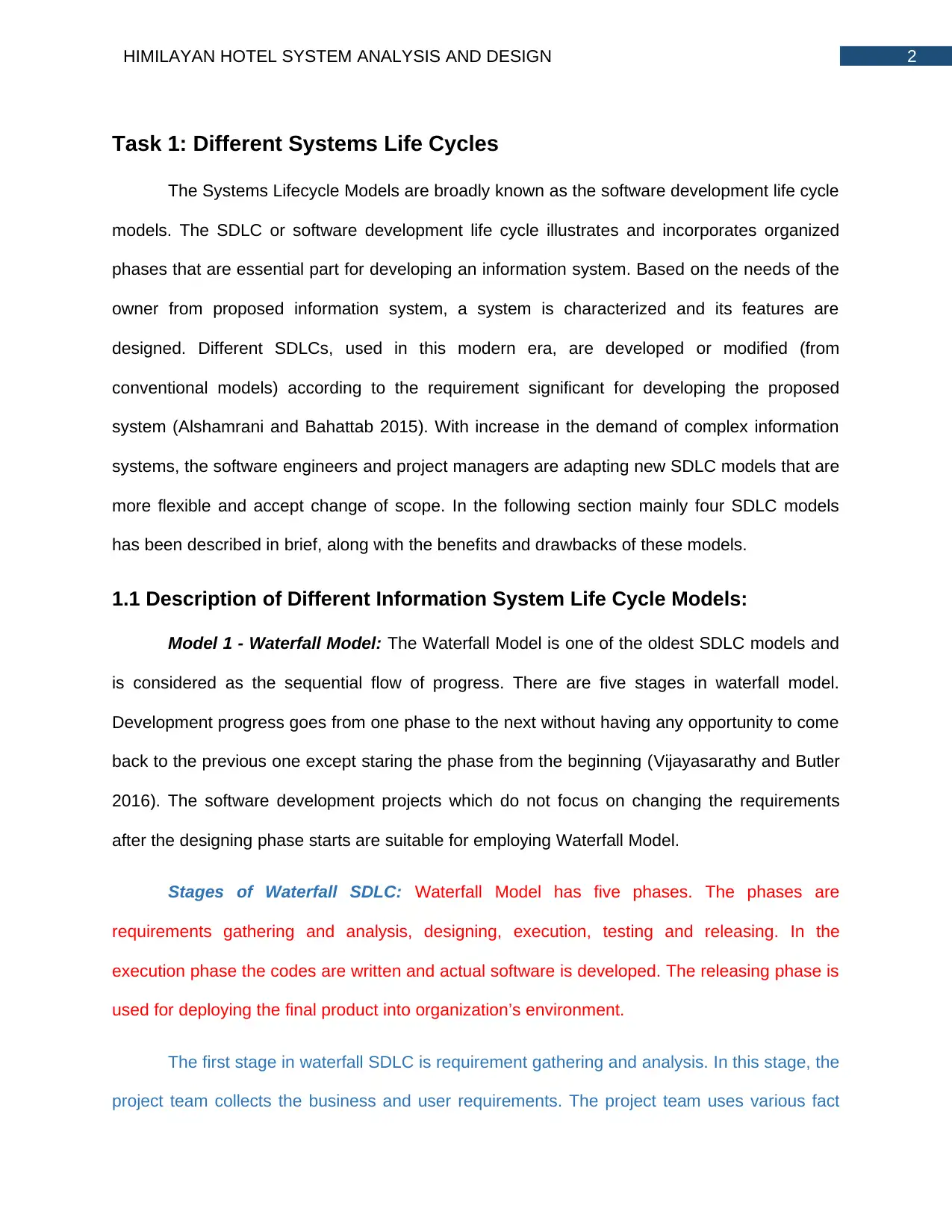
2HIMILAYAN HOTEL SYSTEM ANALYSIS AND DESIGN
Task 1: Different Systems Life Cycles
The Systems Lifecycle Models are broadly known as the software development life cycle
models. The SDLC or software development life cycle illustrates and incorporates organized
phases that are essential part for developing an information system. Based on the needs of the
owner from proposed information system, a system is characterized and its features are
designed. Different SDLCs, used in this modern era, are developed or modified (from
conventional models) according to the requirement significant for developing the proposed
system (Alshamrani and Bahattab 2015). With increase in the demand of complex information
systems, the software engineers and project managers are adapting new SDLC models that are
more flexible and accept change of scope. In the following section mainly four SDLC models
has been described in brief, along with the benefits and drawbacks of these models.
1.1 Description of Different Information System Life Cycle Models:
Model 1 - Waterfall Model: The Waterfall Model is one of the oldest SDLC models and
is considered as the sequential flow of progress. There are five stages in waterfall model.
Development progress goes from one phase to the next without having any opportunity to come
back to the previous one except staring the phase from the beginning (Vijayasarathy and Butler
2016). The software development projects which do not focus on changing the requirements
after the designing phase starts are suitable for employing Waterfall Model.
Stages of Waterfall SDLC: Waterfall Model has five phases. The phases are
requirements gathering and analysis, designing, execution, testing and releasing. In the
execution phase the codes are written and actual software is developed. The releasing phase is
used for deploying the final product into organization’s environment.
The first stage in waterfall SDLC is requirement gathering and analysis. In this stage, the
project team collects the business and user requirements. The project team uses various fact
Task 1: Different Systems Life Cycles
The Systems Lifecycle Models are broadly known as the software development life cycle
models. The SDLC or software development life cycle illustrates and incorporates organized
phases that are essential part for developing an information system. Based on the needs of the
owner from proposed information system, a system is characterized and its features are
designed. Different SDLCs, used in this modern era, are developed or modified (from
conventional models) according to the requirement significant for developing the proposed
system (Alshamrani and Bahattab 2015). With increase in the demand of complex information
systems, the software engineers and project managers are adapting new SDLC models that are
more flexible and accept change of scope. In the following section mainly four SDLC models
has been described in brief, along with the benefits and drawbacks of these models.
1.1 Description of Different Information System Life Cycle Models:
Model 1 - Waterfall Model: The Waterfall Model is one of the oldest SDLC models and
is considered as the sequential flow of progress. There are five stages in waterfall model.
Development progress goes from one phase to the next without having any opportunity to come
back to the previous one except staring the phase from the beginning (Vijayasarathy and Butler
2016). The software development projects which do not focus on changing the requirements
after the designing phase starts are suitable for employing Waterfall Model.
Stages of Waterfall SDLC: Waterfall Model has five phases. The phases are
requirements gathering and analysis, designing, execution, testing and releasing. In the
execution phase the codes are written and actual software is developed. The releasing phase is
used for deploying the final product into organization’s environment.
The first stage in waterfall SDLC is requirement gathering and analysis. In this stage, the
project team collects the business and user requirements. The project team uses various fact
⊘ This is a preview!⊘
Do you want full access?
Subscribe today to unlock all pages.

Trusted by 1+ million students worldwide
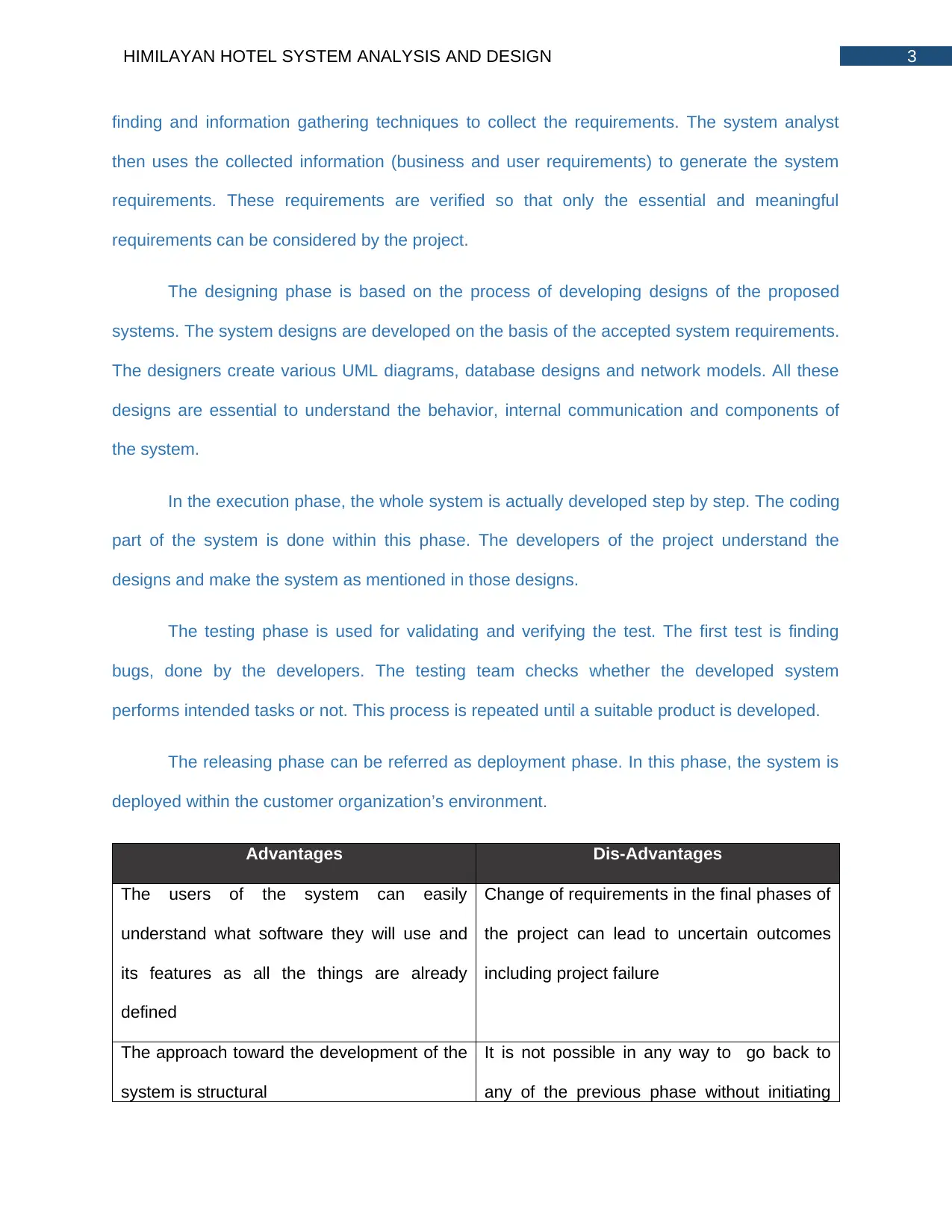
3HIMILAYAN HOTEL SYSTEM ANALYSIS AND DESIGN
finding and information gathering techniques to collect the requirements. The system analyst
then uses the collected information (business and user requirements) to generate the system
requirements. These requirements are verified so that only the essential and meaningful
requirements can be considered by the project.
The designing phase is based on the process of developing designs of the proposed
systems. The system designs are developed on the basis of the accepted system requirements.
The designers create various UML diagrams, database designs and network models. All these
designs are essential to understand the behavior, internal communication and components of
the system.
In the execution phase, the whole system is actually developed step by step. The coding
part of the system is done within this phase. The developers of the project understand the
designs and make the system as mentioned in those designs.
The testing phase is used for validating and verifying the test. The first test is finding
bugs, done by the developers. The testing team checks whether the developed system
performs intended tasks or not. This process is repeated until a suitable product is developed.
The releasing phase can be referred as deployment phase. In this phase, the system is
deployed within the customer organization’s environment.
Advantages Dis-Advantages
The users of the system can easily
understand what software they will use and
its features as all the things are already
defined
Change of requirements in the final phases of
the project can lead to uncertain outcomes
including project failure
The approach toward the development of the
system is structural
It is not possible in any way to go back to
any of the previous phase without initiating
finding and information gathering techniques to collect the requirements. The system analyst
then uses the collected information (business and user requirements) to generate the system
requirements. These requirements are verified so that only the essential and meaningful
requirements can be considered by the project.
The designing phase is based on the process of developing designs of the proposed
systems. The system designs are developed on the basis of the accepted system requirements.
The designers create various UML diagrams, database designs and network models. All these
designs are essential to understand the behavior, internal communication and components of
the system.
In the execution phase, the whole system is actually developed step by step. The coding
part of the system is done within this phase. The developers of the project understand the
designs and make the system as mentioned in those designs.
The testing phase is used for validating and verifying the test. The first test is finding
bugs, done by the developers. The testing team checks whether the developed system
performs intended tasks or not. This process is repeated until a suitable product is developed.
The releasing phase can be referred as deployment phase. In this phase, the system is
deployed within the customer organization’s environment.
Advantages Dis-Advantages
The users of the system can easily
understand what software they will use and
its features as all the things are already
defined
Change of requirements in the final phases of
the project can lead to uncertain outcomes
including project failure
The approach toward the development of the
system is structural
It is not possible in any way to go back to
any of the previous phase without initiating
Paraphrase This Document
Need a fresh take? Get an instant paraphrase of this document with our AI Paraphraser
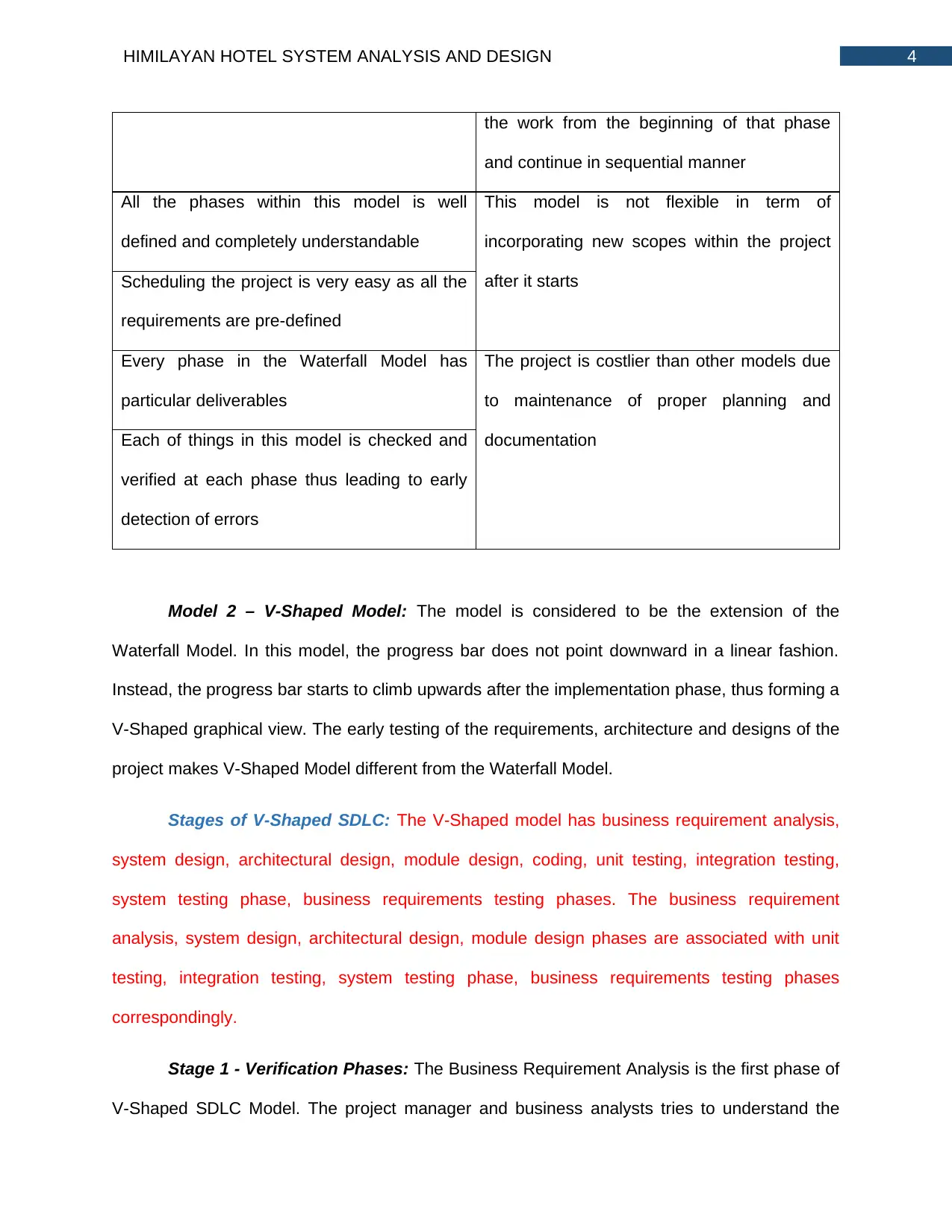
4HIMILAYAN HOTEL SYSTEM ANALYSIS AND DESIGN
the work from the beginning of that phase
and continue in sequential manner
All the phases within this model is well
defined and completely understandable
This model is not flexible in term of
incorporating new scopes within the project
after it startsScheduling the project is very easy as all the
requirements are pre-defined
Every phase in the Waterfall Model has
particular deliverables
The project is costlier than other models due
to maintenance of proper planning and
documentationEach of things in this model is checked and
verified at each phase thus leading to early
detection of errors
Model 2 – V-Shaped Model: The model is considered to be the extension of the
Waterfall Model. In this model, the progress bar does not point downward in a linear fashion.
Instead, the progress bar starts to climb upwards after the implementation phase, thus forming a
V-Shaped graphical view. The early testing of the requirements, architecture and designs of the
project makes V-Shaped Model different from the Waterfall Model.
Stages of V-Shaped SDLC: The V-Shaped model has business requirement analysis,
system design, architectural design, module design, coding, unit testing, integration testing,
system testing phase, business requirements testing phases. The business requirement
analysis, system design, architectural design, module design phases are associated with unit
testing, integration testing, system testing phase, business requirements testing phases
correspondingly.
Stage 1 - Verification Phases: The Business Requirement Analysis is the first phase of
V-Shaped SDLC Model. The project manager and business analysts tries to understand the
the work from the beginning of that phase
and continue in sequential manner
All the phases within this model is well
defined and completely understandable
This model is not flexible in term of
incorporating new scopes within the project
after it startsScheduling the project is very easy as all the
requirements are pre-defined
Every phase in the Waterfall Model has
particular deliverables
The project is costlier than other models due
to maintenance of proper planning and
documentationEach of things in this model is checked and
verified at each phase thus leading to early
detection of errors
Model 2 – V-Shaped Model: The model is considered to be the extension of the
Waterfall Model. In this model, the progress bar does not point downward in a linear fashion.
Instead, the progress bar starts to climb upwards after the implementation phase, thus forming a
V-Shaped graphical view. The early testing of the requirements, architecture and designs of the
project makes V-Shaped Model different from the Waterfall Model.
Stages of V-Shaped SDLC: The V-Shaped model has business requirement analysis,
system design, architectural design, module design, coding, unit testing, integration testing,
system testing phase, business requirements testing phases. The business requirement
analysis, system design, architectural design, module design phases are associated with unit
testing, integration testing, system testing phase, business requirements testing phases
correspondingly.
Stage 1 - Verification Phases: The Business Requirement Analysis is the first phase of
V-Shaped SDLC Model. The project manager and business analysts tries to understand the
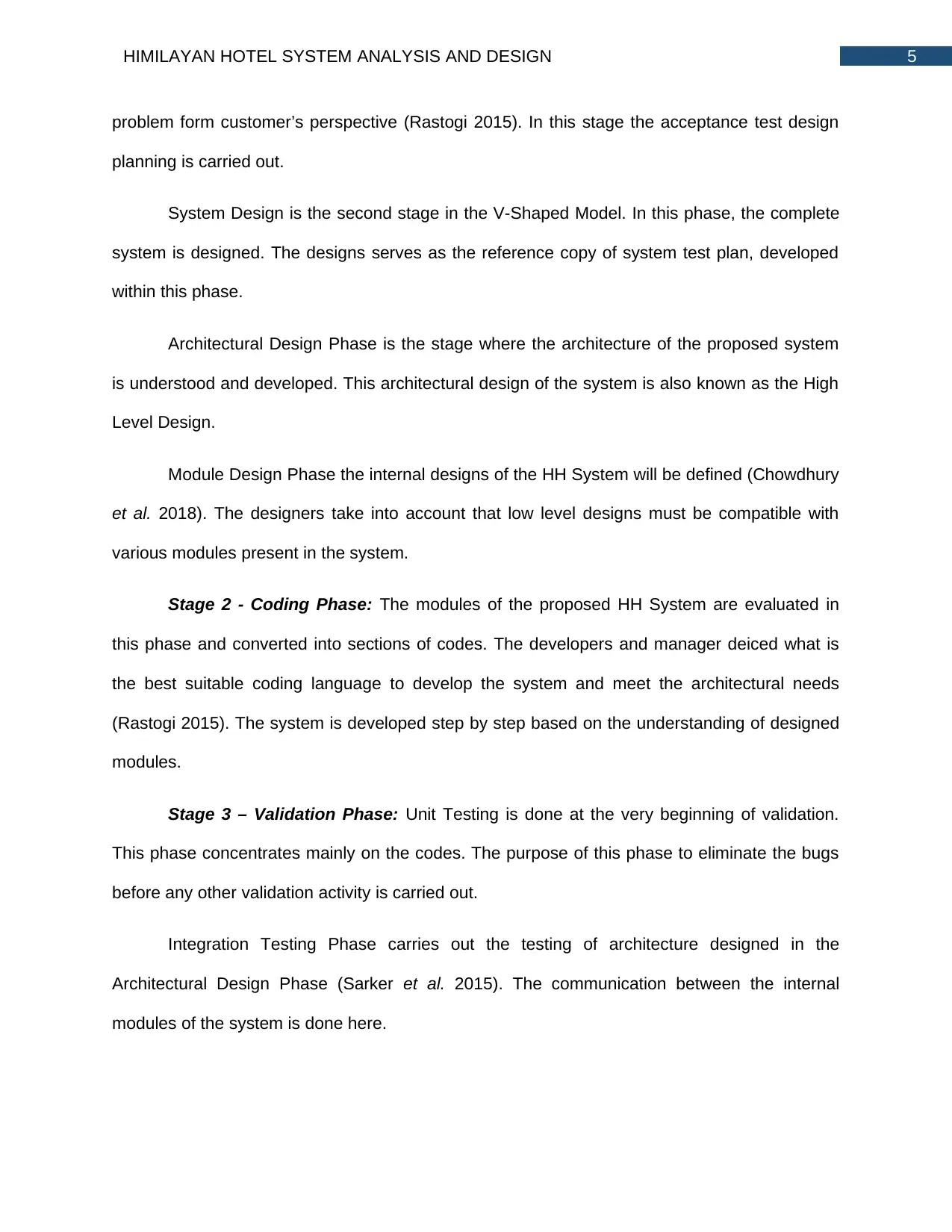
5HIMILAYAN HOTEL SYSTEM ANALYSIS AND DESIGN
problem form customer’s perspective (Rastogi 2015). In this stage the acceptance test design
planning is carried out.
System Design is the second stage in the V-Shaped Model. In this phase, the complete
system is designed. The designs serves as the reference copy of system test plan, developed
within this phase.
Architectural Design Phase is the stage where the architecture of the proposed system
is understood and developed. This architectural design of the system is also known as the High
Level Design.
Module Design Phase the internal designs of the HH System will be defined (Chowdhury
et al. 2018). The designers take into account that low level designs must be compatible with
various modules present in the system.
Stage 2 - Coding Phase: The modules of the proposed HH System are evaluated in
this phase and converted into sections of codes. The developers and manager deiced what is
the best suitable coding language to develop the system and meet the architectural needs
(Rastogi 2015). The system is developed step by step based on the understanding of designed
modules.
Stage 3 – Validation Phase: Unit Testing is done at the very beginning of validation.
This phase concentrates mainly on the codes. The purpose of this phase to eliminate the bugs
before any other validation activity is carried out.
Integration Testing Phase carries out the testing of architecture designed in the
Architectural Design Phase (Sarker et al. 2015). The communication between the internal
modules of the system is done here.
problem form customer’s perspective (Rastogi 2015). In this stage the acceptance test design
planning is carried out.
System Design is the second stage in the V-Shaped Model. In this phase, the complete
system is designed. The designs serves as the reference copy of system test plan, developed
within this phase.
Architectural Design Phase is the stage where the architecture of the proposed system
is understood and developed. This architectural design of the system is also known as the High
Level Design.
Module Design Phase the internal designs of the HH System will be defined (Chowdhury
et al. 2018). The designers take into account that low level designs must be compatible with
various modules present in the system.
Stage 2 - Coding Phase: The modules of the proposed HH System are evaluated in
this phase and converted into sections of codes. The developers and manager deiced what is
the best suitable coding language to develop the system and meet the architectural needs
(Rastogi 2015). The system is developed step by step based on the understanding of designed
modules.
Stage 3 – Validation Phase: Unit Testing is done at the very beginning of validation.
This phase concentrates mainly on the codes. The purpose of this phase to eliminate the bugs
before any other validation activity is carried out.
Integration Testing Phase carries out the testing of architecture designed in the
Architectural Design Phase (Sarker et al. 2015). The communication between the internal
modules of the system is done here.
⊘ This is a preview!⊘
Do you want full access?
Subscribe today to unlock all pages.

Trusted by 1+ million students worldwide
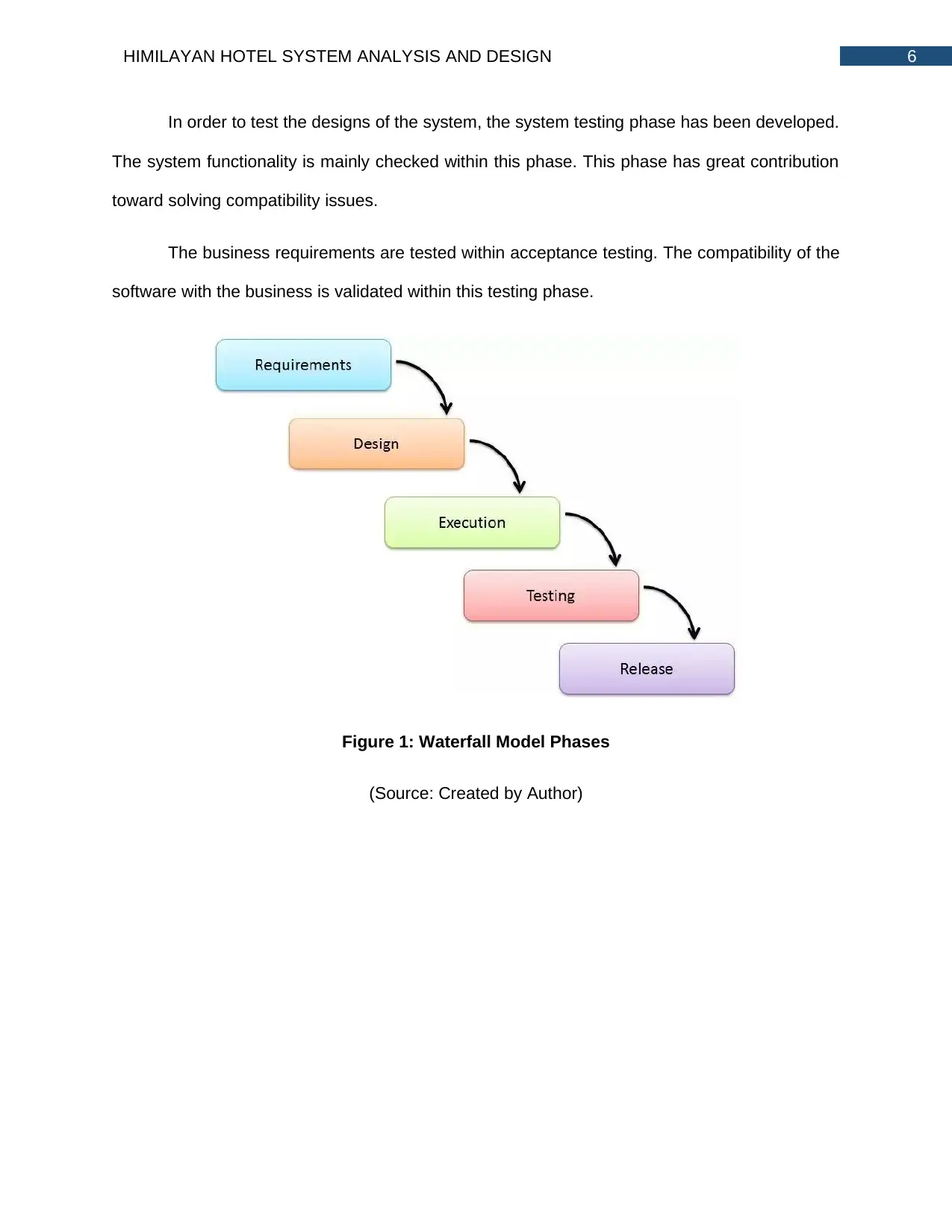
6HIMILAYAN HOTEL SYSTEM ANALYSIS AND DESIGN
In order to test the designs of the system, the system testing phase has been developed.
The system functionality is mainly checked within this phase. This phase has great contribution
toward solving compatibility issues.
The business requirements are tested within acceptance testing. The compatibility of the
software with the business is validated within this testing phase.
Figure 1: Waterfall Model Phases
(Source: Created by Author)
In order to test the designs of the system, the system testing phase has been developed.
The system functionality is mainly checked within this phase. This phase has great contribution
toward solving compatibility issues.
The business requirements are tested within acceptance testing. The compatibility of the
software with the business is validated within this testing phase.
Figure 1: Waterfall Model Phases
(Source: Created by Author)
Paraphrase This Document
Need a fresh take? Get an instant paraphrase of this document with our AI Paraphraser
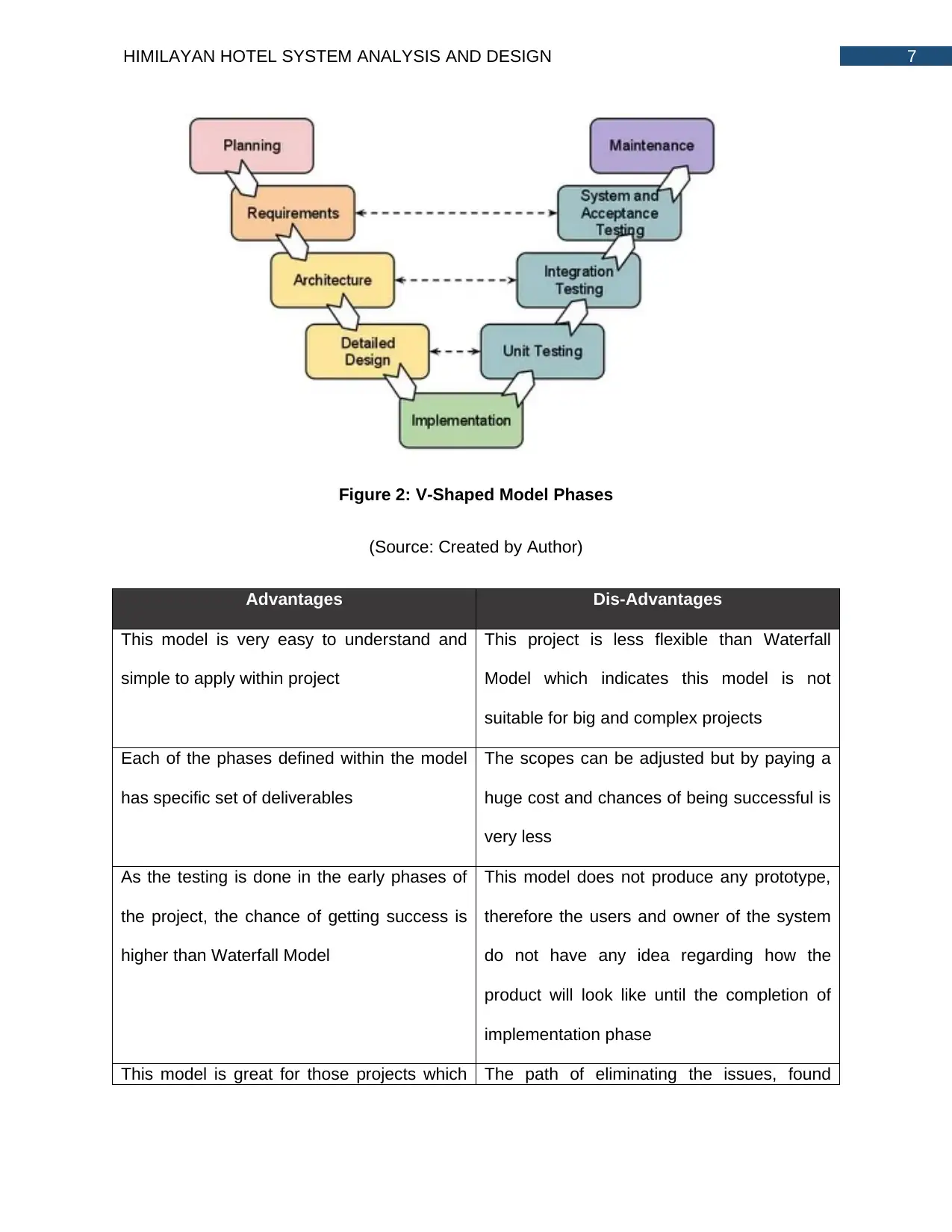
7HIMILAYAN HOTEL SYSTEM ANALYSIS AND DESIGN
Figure 2: V-Shaped Model Phases
(Source: Created by Author)
Advantages Dis-Advantages
This model is very easy to understand and
simple to apply within project
This project is less flexible than Waterfall
Model which indicates this model is not
suitable for big and complex projects
Each of the phases defined within the model
has specific set of deliverables
The scopes can be adjusted but by paying a
huge cost and chances of being successful is
very less
As the testing is done in the early phases of
the project, the chance of getting success is
higher than Waterfall Model
This model does not produce any prototype,
therefore the users and owner of the system
do not have any idea regarding how the
product will look like until the completion of
implementation phase
This model is great for those projects which The path of eliminating the issues, found
Figure 2: V-Shaped Model Phases
(Source: Created by Author)
Advantages Dis-Advantages
This model is very easy to understand and
simple to apply within project
This project is less flexible than Waterfall
Model which indicates this model is not
suitable for big and complex projects
Each of the phases defined within the model
has specific set of deliverables
The scopes can be adjusted but by paying a
huge cost and chances of being successful is
very less
As the testing is done in the early phases of
the project, the chance of getting success is
higher than Waterfall Model
This model does not produce any prototype,
therefore the users and owner of the system
do not have any idea regarding how the
product will look like until the completion of
implementation phase
This model is great for those projects which The path of eliminating the issues, found
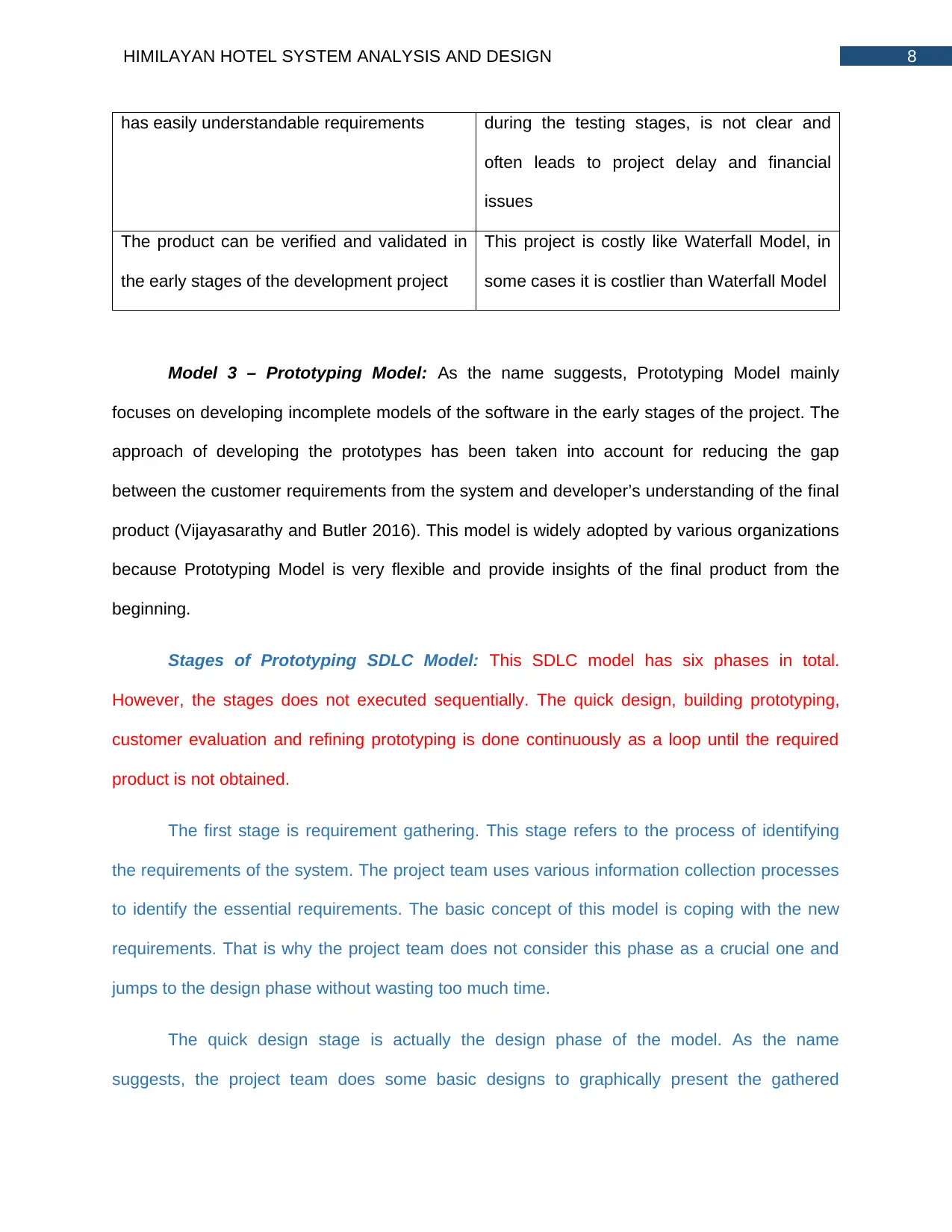
8HIMILAYAN HOTEL SYSTEM ANALYSIS AND DESIGN
has easily understandable requirements during the testing stages, is not clear and
often leads to project delay and financial
issues
The product can be verified and validated in
the early stages of the development project
This project is costly like Waterfall Model, in
some cases it is costlier than Waterfall Model
Model 3 – Prototyping Model: As the name suggests, Prototyping Model mainly
focuses on developing incomplete models of the software in the early stages of the project. The
approach of developing the prototypes has been taken into account for reducing the gap
between the customer requirements from the system and developer’s understanding of the final
product (Vijayasarathy and Butler 2016). This model is widely adopted by various organizations
because Prototyping Model is very flexible and provide insights of the final product from the
beginning.
Stages of Prototyping SDLC Model: This SDLC model has six phases in total.
However, the stages does not executed sequentially. The quick design, building prototyping,
customer evaluation and refining prototyping is done continuously as a loop until the required
product is not obtained.
The first stage is requirement gathering. This stage refers to the process of identifying
the requirements of the system. The project team uses various information collection processes
to identify the essential requirements. The basic concept of this model is coping with the new
requirements. That is why the project team does not consider this phase as a crucial one and
jumps to the design phase without wasting too much time.
The quick design stage is actually the design phase of the model. As the name
suggests, the project team does some basic designs to graphically present the gathered
has easily understandable requirements during the testing stages, is not clear and
often leads to project delay and financial
issues
The product can be verified and validated in
the early stages of the development project
This project is costly like Waterfall Model, in
some cases it is costlier than Waterfall Model
Model 3 – Prototyping Model: As the name suggests, Prototyping Model mainly
focuses on developing incomplete models of the software in the early stages of the project. The
approach of developing the prototypes has been taken into account for reducing the gap
between the customer requirements from the system and developer’s understanding of the final
product (Vijayasarathy and Butler 2016). This model is widely adopted by various organizations
because Prototyping Model is very flexible and provide insights of the final product from the
beginning.
Stages of Prototyping SDLC Model: This SDLC model has six phases in total.
However, the stages does not executed sequentially. The quick design, building prototyping,
customer evaluation and refining prototyping is done continuously as a loop until the required
product is not obtained.
The first stage is requirement gathering. This stage refers to the process of identifying
the requirements of the system. The project team uses various information collection processes
to identify the essential requirements. The basic concept of this model is coping with the new
requirements. That is why the project team does not consider this phase as a crucial one and
jumps to the design phase without wasting too much time.
The quick design stage is actually the design phase of the model. As the name
suggests, the project team does some basic designs to graphically present the gathered
⊘ This is a preview!⊘
Do you want full access?
Subscribe today to unlock all pages.

Trusted by 1+ million students worldwide

9HIMILAYAN HOTEL SYSTEM ANALYSIS AND DESIGN
requirements. These designs are enough to establish a general idea of the components of the
system.
In the prototype building part, the system components are created separately. The
project team does not develop the final product as a whole, instead they develop different
components of the system one at a time.
Customers have a great part in this mythology. The developed prototypes are evaluated
by allowing the customers to use it and provide their feedbacks. These feedbacks are collected
and analyzed. The suitable feedbacks are considered to be valid and used for redeveloping the
prototypes.
In the next phase, the prototypes are modified based on the feedbacks of the customers.
In some cases, almost fifty percent of the actual model is changed. After the model is
considered to be properly functioning and meets customer needs, the product is send to next
phase.
At the final stage, the engineer product, all the developed prototypes are brought
together and a complete product is developed. The product is also deployed in the customer
environment in this phase.
Figure 3: Prototyping Model Phases
(Source: Created by Author)
requirements. These designs are enough to establish a general idea of the components of the
system.
In the prototype building part, the system components are created separately. The
project team does not develop the final product as a whole, instead they develop different
components of the system one at a time.
Customers have a great part in this mythology. The developed prototypes are evaluated
by allowing the customers to use it and provide their feedbacks. These feedbacks are collected
and analyzed. The suitable feedbacks are considered to be valid and used for redeveloping the
prototypes.
In the next phase, the prototypes are modified based on the feedbacks of the customers.
In some cases, almost fifty percent of the actual model is changed. After the model is
considered to be properly functioning and meets customer needs, the product is send to next
phase.
At the final stage, the engineer product, all the developed prototypes are brought
together and a complete product is developed. The product is also deployed in the customer
environment in this phase.
Figure 3: Prototyping Model Phases
(Source: Created by Author)
Paraphrase This Document
Need a fresh take? Get an instant paraphrase of this document with our AI Paraphraser

10HIMILAYAN HOTEL SYSTEM ANALYSIS AND DESIGN
Advantages Dis-Advantages
The cost for implementing this model far less
than Waterfall Model. Moreover, the model
requires less time.
The analysis is not effective. If the user is not
able to understand the prototype and does
not have any idea regarding the final product,
the project will suffer in the long run
The possibility of delivering wring user
objectives to the developers is very high
The involvement of the user in the project is
significant
The additional time required for developing
the prototypes increase complexity
The prototype implements are costly
approach so project manager cuts down
other project related activities
Model 4 – Spiral Model: If the elements of prototyping and designing is combined in a
specific model then it would result in holding advantages of both the top-down and bottom-up.
The reason behind the successful adoption within numerous of software development projects
is having both the top-down and bottom-up benefits (Alshamrani and Bahattab 2015). This
model is well-known for its capability of combining characteristics of Waterfall Model and
Prototyping Model.
Advantages Dis-Advantages
The cost for implementing this model far less
than Waterfall Model. Moreover, the model
requires less time.
The analysis is not effective. If the user is not
able to understand the prototype and does
not have any idea regarding the final product,
the project will suffer in the long run
The possibility of delivering wring user
objectives to the developers is very high
The involvement of the user in the project is
significant
The additional time required for developing
the prototypes increase complexity
The prototype implements are costly
approach so project manager cuts down
other project related activities
Model 4 – Spiral Model: If the elements of prototyping and designing is combined in a
specific model then it would result in holding advantages of both the top-down and bottom-up.
The reason behind the successful adoption within numerous of software development projects
is having both the top-down and bottom-up benefits (Alshamrani and Bahattab 2015). This
model is well-known for its capability of combining characteristics of Waterfall Model and
Prototyping Model.
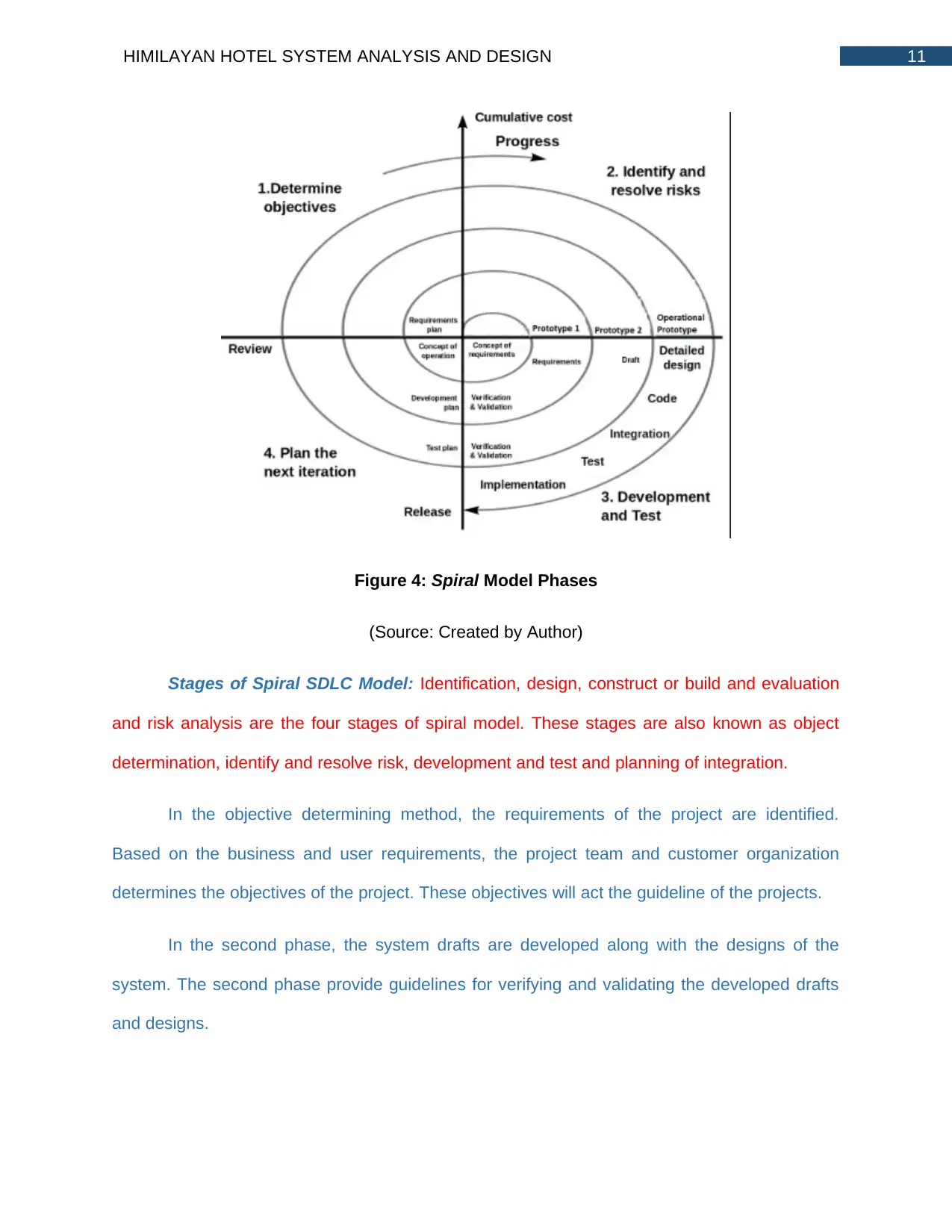
11HIMILAYAN HOTEL SYSTEM ANALYSIS AND DESIGN
Figure 4: Spiral Model Phases
(Source: Created by Author)
Stages of Spiral SDLC Model: Identification, design, construct or build and evaluation
and risk analysis are the four stages of spiral model. These stages are also known as object
determination, identify and resolve risk, development and test and planning of integration.
In the objective determining method, the requirements of the project are identified.
Based on the business and user requirements, the project team and customer organization
determines the objectives of the project. These objectives will act the guideline of the projects.
In the second phase, the system drafts are developed along with the designs of the
system. The second phase provide guidelines for verifying and validating the developed drafts
and designs.
Figure 4: Spiral Model Phases
(Source: Created by Author)
Stages of Spiral SDLC Model: Identification, design, construct or build and evaluation
and risk analysis are the four stages of spiral model. These stages are also known as object
determination, identify and resolve risk, development and test and planning of integration.
In the objective determining method, the requirements of the project are identified.
Based on the business and user requirements, the project team and customer organization
determines the objectives of the project. These objectives will act the guideline of the projects.
In the second phase, the system drafts are developed along with the designs of the
system. The second phase provide guidelines for verifying and validating the developed drafts
and designs.
⊘ This is a preview!⊘
Do you want full access?
Subscribe today to unlock all pages.

Trusted by 1+ million students worldwide
1 out of 30
Related Documents
Your All-in-One AI-Powered Toolkit for Academic Success.
+13062052269
info@desklib.com
Available 24*7 on WhatsApp / Email
![[object Object]](/_next/static/media/star-bottom.7253800d.svg)
Unlock your academic potential
Copyright © 2020–2025 A2Z Services. All Rights Reserved. Developed and managed by ZUCOL.





